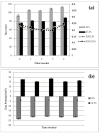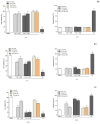Stealth and Cationic Nanoliposomes as Drug Delivery Systems to Increase Andrographolide BBB Permeability
- PMID: 30104484
- PMCID: PMC6161272
- DOI: 10.3390/pharmaceutics10030128
Stealth and Cationic Nanoliposomes as Drug Delivery Systems to Increase Andrographolide BBB Permeability
Abstract
(1) Background: Andrographolide (AG) is a natural compound effective for the treatment of inflammation-mediated neurodegenerative disorders. The aim of this investigation was the preparation of liposomes to enhance the penetration into the brain of AG, by modifying the surface of the liposomes by adding Tween 80 (LPs-AG) alone or in combination with Didecyldimethylammonium bromide (DDAB) (CLPs-AG). (2) Methods: LPs-AG and CLPs-AG were physically and chemically characterized. The ability of liposomes to increase the permeability of AG was evaluated by artificial membranes (PAMPA) and hCMEC/D3 cells. (3) Results: Based on obtained results in terms of size, homogeneity, ζ-potential and EE%. both liposomes are suitable for parenteral administration. The systems showed excellent stability during a month of storage as suspensions or freeze-dried products. Glucose resulted the best cryoprotectant agent. PAMPA and hCMEC/D3 transport studies revealed that LPs-AG and CLPs-AG increased the permeability of AG, about an order of magnitude, compared to free AG without alterations in cell viability. The caveolae-mediated endocytosis resulted the main mechanism of up-take for both formulations. The presence of positive charge increased the cellular internalization of nanoparticles. (4) Conclusions: This study shows that developed liposomes might be ideal candidates for brain delivery of AG.
Keywords: PAMPA; andrographolide; brain delivery; cationic liposomes; hCMEC/D3 cells; liposomes; surfactant.
Conflict of interest statement
The authors declare no conflict of interest.
Figures







Similar articles
-
Solid lipid nanoparticles for delivery of andrographolide across the blood-brain barrier: in vitro and in vivo evaluation.Colloids Surf B Biointerfaces. 2018 Jan 1;161:302-313. doi: 10.1016/j.colsurfb.2017.10.062. Epub 2017 Nov 6. Colloids Surf B Biointerfaces. 2018. PMID: 29096375
-
Andrographolide-loaded nanoparticles for brain delivery: Formulation, characterisation and in vitro permeability using hCMEC/D3 cell line.Eur J Pharm Biopharm. 2017 Oct;119:253-263. doi: 10.1016/j.ejpb.2017.06.018. Epub 2017 Jun 23. Eur J Pharm Biopharm. 2017. PMID: 28652141
-
Development and Blood-Brain Barrier Penetration of Nanovesicles Loaded with Cannabidiol.Pharmaceuticals (Basel). 2025 Jan 25;18(2):160. doi: 10.3390/ph18020160. Pharmaceuticals (Basel). 2025. PMID: 40005974 Free PMC article.
-
Charged liposomes as carriers to enhance the permeation through the skin.Expert Opin Drug Deliv. 2011 Jul;8(7):857-71. doi: 10.1517/17425247.2011.574610. Epub 2011 May 11. Expert Opin Drug Deliv. 2011. PMID: 21557706 Review.
-
Nano carriers for drug transport across the blood-brain barrier.J Drug Target. 2017 Jan;25(1):17-28. doi: 10.1080/1061186X.2016.1184272. Epub 2016 May 19. J Drug Target. 2017. PMID: 27126681 Review.
Cited by
-
Induced Vascular Normalization-Can One Force Tumors to Surrender to a Better Microenvironment?Pharmaceutics. 2023 Jul 26;15(8):2022. doi: 10.3390/pharmaceutics15082022. Pharmaceutics. 2023. PMID: 37631236 Free PMC article. Review.
-
Synthesis and Biological Evaluation of Novel Ramalin Derivatives as Multi-Target Agents for Alzheimer's Disease.Molecules. 2025 May 2;30(9):2030. doi: 10.3390/molecules30092030. Molecules. 2025. PMID: 40363835 Free PMC article.
-
Advances in Nano-Enabled Platforms for the Treatment of Depression.Polymers (Basel). 2021 Apr 29;13(9):1431. doi: 10.3390/polym13091431. Polymers (Basel). 2021. PMID: 33946703 Free PMC article. Review.
-
PEGylated liposomes enhance the effect of cytotoxic drug: A review.Heliyon. 2023 Feb 17;9(3):e13823. doi: 10.1016/j.heliyon.2023.e13823. eCollection 2023 Mar. Heliyon. 2023. PMID: 36873538 Free PMC article.
-
Functionalized Nanomaterials Capable of Crossing the Blood-Brain Barrier.ACS Nano. 2024 Jan 23;18(3):1820-1845. doi: 10.1021/acsnano.3c10674. Epub 2024 Jan 9. ACS Nano. 2024. PMID: 38193927 Free PMC article. Review.
References
-
- Bilia A.R., Bergonzi M.C., Guccione C., Manconi M., Fadda A.M., Sinico C. Vesicles and micelles: Two versatile vectors for the delivery of natural products. J. Drug Deliv. Sc. Technol. 2016;32:241–255. doi: 10.1016/j.jddst.2015.09.007. - DOI
-
- Conti E., Gregori M., Radice I., Da Re F., Grana D., Re F., Salvati E., Masserini M., Ferrarese C., Zola C.P., et al. Multifunctional liposomes interact with Abeta in human biological fluids: Therapeutic implications for Alzheimer’s disease. Neurochem. Int. 2017;108:60–65. doi: 10.1016/j.neuint.2017.02.012. - DOI - PubMed
LinkOut - more resources
Full Text Sources
Other Literature Sources
Miscellaneous

